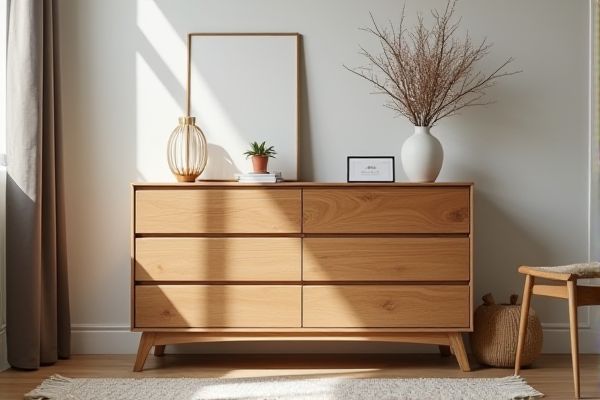
A drawer chest typically features a taller, more vertical design with multiple deep drawers ideal for storing folded clothes, while a dresser usually offers a wider, lower profile with a combination of drawers and sometimes a mirror, perfect for bedroom organization. Discover which option best fits Your space and storage needs by exploring the rest of this article.
Table of Comparison
| Feature | Drawer Chest | Dresser |
|---|---|---|
| Design | Tall and narrow with multiple deep drawers | Wide and low with broad surface area and multiple drawers |
| Primary Use | Storing folded clothes, smaller items in compact spaces | Storage for clothes and display surface for decor or mirror |
| Space Efficiency | Ideal for small rooms or closets | Better for larger rooms with ample floor space |
| Surface Area | Limited top surface | Broad top surface suitable for mirrors and decorations |
| Height | Taller, vertical design | Shorter, horizontal design |
| Common Materials | Wood, MDF, metal | Wood, MDF, metal, sometimes with glass tops |
Introduction: Drawer Chest vs Dresser
A drawer chest typically features a taller and narrower design with multiple deep drawers, making it ideal for maximizing vertical storage in smaller spaces. Dressers tend to be wider and shorter with a combination of wide drawers and sometimes a mirror, offering more surface area for organizing and displaying items. Choosing the right piece depends on your room layout and storage needs, helping you optimize both space and functionality.
Defining Drawer Chest
A drawer chest is a tall, vertical storage piece featuring multiple stacked drawers designed to save floor space while maximizing storage capacity. Unlike a dresser, which often has a broader surface and may include a mirror, a drawer chest emphasizes drawer height and depth for efficient organization of clothing and accessories. Understanding your storage needs helps determine if a drawer chest's compact design aligns better with your room layout compared to a traditional dresser.
Defining Dresser
A dresser is a bedroom furniture piece designed with multiple horizontal drawers stacked vertically, primarily used for storing clothes and personal items. It often features a larger surface area on top for placing decorative items or a mirror. Unlike drawer chests, dressers tend to be wider and shorter, optimizing both storage capacity and accessibility.
Key Differences Between Drawer Chests and Dressers
Drawer chests typically feature a taller and narrower design with multiple drawers stacked vertically, offering ample storage for folded clothes or smaller items. Dressers are usually wider and lower, providing a larger surface area on top and often include a combination of drawers and cabinet space for versatile storage. The structural layout of drawer chests maximizes vertical space, while dressers prioritize horizontal space, influencing their placement and functional use in bedrooms.
Storage Capacity Comparison
A drawer chest typically offers taller, narrower storage with deep drawers ideal for organizing smaller clothing items or accessories, while a dresser provides wider, shallower drawers suited for folded clothes and larger items. The storage capacity of your dresser often surpasses that of a drawer chest due to its horizontal layout, allowing you to store more bulkier pieces efficiently. Choosing between the two depends on your specific storage needs and the type of clothing or items you plan to organize.
Design and Style Variations
Drawer chests and dressers offer distinct design and style variations that cater to diverse interior preferences. Drawer chests typically feature taller, narrower profiles with multiple stacked drawers, ideal for maximizing vertical storage in compact spaces. Dressers usually present wider, lower constructions with a combination of large and small drawers, often complemented by integrated mirrors or decorative elements to enhance bedroom aesthetics.
Space and Placement Considerations
A drawer chest is typically taller with a smaller footprint, making it ideal for narrow spaces or rooms with limited floor area, while a dresser is wider and lower, requiring more floor space but offering a surface for decor or a mirror. Drawer chests can fit comfortably in tight corners or between windows, optimizing vertical storage without encroaching on walking areas. Dressers work well against longer walls or in spacious bedrooms where horizontal space allows for easy access to multiple drawers simultaneously.
Pros and Cons of Drawer Chests
Drawer chests offer tall, vertical storage that maximizes space efficiency, making them ideal for small bedrooms or tight corners. Their narrow design allows for easy organization of clothes and accessories, but they may have limited surface area on top compared to dressers. You benefit from better space utilization, though drawer chests often provide less countertop space for decor or daily essentials.
Pros and Cons of Dressers
Dressers offer ample storage space with multiple drawers, making organization of clothing and accessories convenient for your bedroom. They tend to be larger and heavier, which can limit mobility and require more space compared to drawer chests. While dressers provide a broad surface area for decor or personal items, they may lack the vertical storage efficiency found in drawer chests.
Which Is Best for Your Needs?
A drawer chest offers a vertical storage solution ideal for smaller spaces, maximizing storage with deep, stacked drawers that keep clothing organized and accessible. A dresser provides a wider, more spacious surface suitable for placing decor or daily essentials, often featuring a combination of drawer sizes for versatile storage. Your choice depends on room dimensions, storage quantity, and whether surface space is important for your daily routine or aesthetic preferences.
 homyna.com
homyna.com